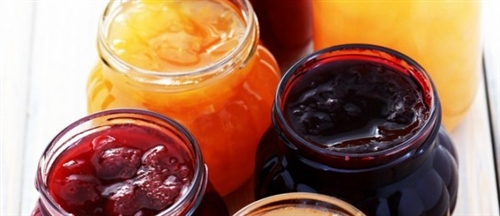HONEY, JAMS AND MARMELLADES

Honey is the most ancient sweetener and has been used by mankind for long time as supplement to the income for many businesses and families. For this reason, in our region, beekeeping has been a very popular activity that led to the definition of modern apiculture based on the introduction and spread of hives with movable frames and innovative techniques of collection.
The province of Forlì-Cesena is a great producer of honey, which comes mainly from the hills side where meadows and tree crops (acacia, chestnut, wild plum), has multiple blooms but it is significant also in lowland areas where are cultivated alfalfa and sunflowers.
The main honeys of the province are: Millefiori, which represents the greatest amount of production; Acacia honey with a pale color and delicate flavor; Linden honey with color a bit darker, characterized by a slightly minty smell; Alfalfa honey with an amber light in color which tends to crystallize; Sunflower honey with a golden yellow color and delicate taste; Chestnut honey is dark amber colored, liquid with a bitter aftertaste and then honey from Honeydew of Fir, very dark, with a taste of resin, caramelized sugar and balsamic.
Marmalades born with the aim to keep the fruits of periods of abundance and store it order to be able consume in periods when it is absent or very scarce.
The origin of the marmalades seems to be very ancient: the Greeks used to cook for a long quinces with honey to keep them longer while at the time of the Romans were produced "marmalades" by mixing different kinds of fruit with wine, must or honey. It was used as a preservative honey or must because the sugar will be introduced in Europe only in the period of the Crusades.
In the Middle Ages the process of production was equal to that of ours and after the discovery of America and the introduction of the cultivation of sugar cane, spread all over Europe.
If in common language there is no difference between "marmalade" and "jam", in reality a European directive clarifies well the different features:
marmalade is a product made from citrus fruits (at least 20% of fruit); jam, however, is a compound made ??with any other type of fruit, (at least 35% in the compound of 45% in normal and extra jam). Gelatin, however, is a compound made using only the juice of the fruit without the peel or pulp.
Even in Romagna families used this process to make available all year perishable products and so integrate with vitamins and sugars that a diet during the winter months that would have been very poor.
Today are produced jams and marmalades of all tastes, but in the tradition of Romagna two products stand out in particular: the Saba and Savor.
The
Saba or
Sapa is a sugary syrup made from the must of white or black grapes.
Once placed on the fire is boiled slowly, skimming periodically until reaching the right consistency, that is up to a reduction of over two-thirds compared to the initial volume. The resulting liquid is thick, syrupy, and dark, with a pleasant taste and aroma. The Saba is used as a topping on sweet stuff and Migliaccio and it is the first ingredient for making Savor, a particular marmalade with must and fruits.
It combine very well also with cheese, grilled polenta, cooked fruit or boiled chestnuts.
The Saba is also used for Sabadoni, sweet ravioli stuffed with chestnuts, beans and saba, which can be cooked in boiling water or on oven, and covered with saba. Among the desserts of harvest period, there is also the Sugali, a pudding made ??with flour, sugar and fresh must.
The Saba has ancient origins: in fact it was used by the Romans in place of honey, to sweeten their wine and to give more taste and flavor to food. Pliny tells us that when the Emperor Augustus had lunch in Bologna at a rich veteran Antonio, were served some dishes with cooked must. The Saba is also mentioned by Ludovico Ariosto in Satire III, written in 1518: the author of Reggio Emilia, speaking with his cousin talks about his new job, refuses ecclesiastical career and defends his dignity. In particular, complaining of his precarious economic situation, he describe his meal speaking also about Saba.
The famous gastronome Pellegrino Artusi describes the saba in chapter syrups, as a "grape syrup (which) can serve a variety of uses in the kitchen since it has a special flavor ".
The
Savor (
Savour) was a product which after the war and with the advent of industrial production, it was almost lost.
The name itself confirms its intense and distinctive flavor.
It is a kind of energy and tasty marmalade of many different fruits, blended with must and prepared with a long cooking. Strictly homemade, it is linked to ancient rural traditions and is prepared in the period just after the harvest.
The base ingredients are quinces, pears, walnuts, hazelnuts and almonds, melon and lemon peel, dried fruit, candied fruit and raisins. Essential ingredient is also the Saba or concentrated must, long-cooked.
The must comes from black or white selected grapes, fully ripe, which is appropriately filtered and baked before the beginning of the fermentation. It takes 5 liters of must to put in the pot, or in the classic copper pot over an open fire; when it begins to boil the flame ha sto be lowered and the foam ha sto be stimme of.
Half cooked of the must, after about 4 hours, was reduced in half. Now you add all the ingredients available, which must be cooked for another 5-6 hours over low heat.
The Savor can be used as jam on bread, tarts or on cantarelle carnival, irreplaceable to accompany the of Fossa cheese.
Typical Products